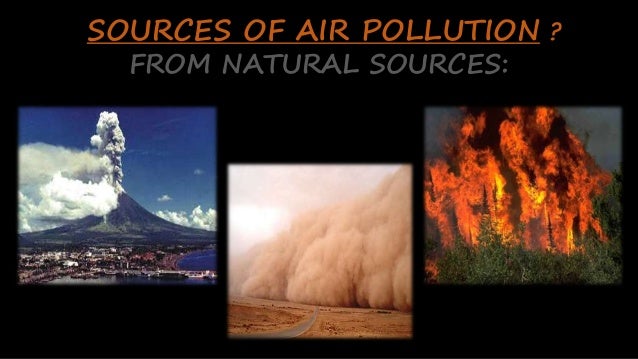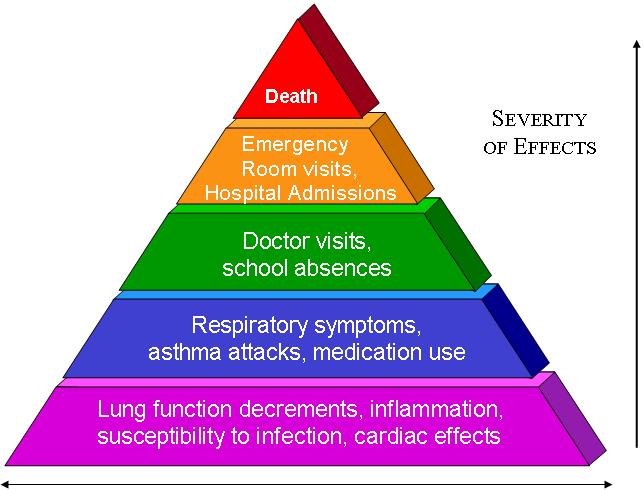Chapter 12- Air Quality and Pollution
Chapter 12- Air Quality and Pollution
Definition of haze
- Haze is traditionally an atmospheric phenomenon where dust, smoke and other dry particles obscure the clarity of the sky.
- It is caused when sunlight encounters tiny pollution particles in the air.
- Some light is absorbed by particles while other light is scattered away before it reaches an observer.
- The more the pollutants,the more the absorption and scattering of light, which reduces the clarity and colour of what we see.

(source: http://www.vadscorner.com/internet67.html)
Health Effect of Haze:
- It can affect the heart and lungs, especially in people who already have chronic heart or lung disease e.g. asthma, chronic obstructive pulmonary disease (COPD), or heart failure.
- When inhaled, they can enter the bloodstream and get absorbed by underlying tissue, potentially interacting with other compounds and substances in the body.
There are 2 term effects of exposure to haze:
(a) Short-term adverse effects of exposure to haze
These symptoms are usually mild and will subside if exposure to haze is limited by staying indoors. It effects are:
- Eye irritation, watering eyes, and/or conjunctivitis (a type of eye inflammation)
- Running nose, stuffy nose, sneezing, and/or post-nasal drip.
- Throat irritation, dry throat, sore throat and/or coughing, phlegm.
- Headache, dizziness, fatigue and/or stress.
(b) Long-term effects of exposure to haze
- A large number of particles in a haze are below 2.5 micrometers in diameter. Therefore these ultra small particles stay in the air longer and are easily carried over long distances, increasing their chances of being inhaled by animals and humans.
- The long-term risks associated with exposure to fine particles:
(i)Faster rate of thickening of the arteries compared to others, promoting the development of vascular diseases.
(ii) Increases the risk of death by cardiovascular disease and reduces life expectancy by several months to a few years.
(iii)May contribute to the development of diabetes.
(iv)Spontaneous abortion, under-weight infants, birth defects and infant death.
How to reduce those terms?
(a) General Measures at the Workplace
- Minimize outdoor activities.
- Identify outdoor work that may be reduced.
- Close all windows, doors and any openings that may allow haze to enter the workplace.
- Turn on the air conditioner if available.
- Ensure maintenance of the air conditioner with regular cleaning and servicing.
- Use an air purifier to keep the particulate levels low.
- Provide health education regarding haze to the employees
- Provide respirators for employees who have to work outdoors
- Ensure there is sufficient supply of respirators for employees who have to work outdoors.
(b) General Measures for the Workers
- Inform the management if you are suffering from any heart or respiratory diseases
- Take your medication regularly if suffering from an existing disease, especially heart disease and respiratory diseases.
- Drink more water and increase the intake of fresh fruits and vegetables.
- Cut down on alcohol and coffee.
- Avoid smoking.
- Wear a respirator when you go outside.
Source of air pollution

(source: http://butane.chem.uiuc.edu/pshapley/environmental/l17/index.html)
There are 2 source air pollution:
(a) Natural resources

(source: http://www.slideshare.net/MAYANKGUPTA264/impacts-of-air-pollution-on-human-beings)
(b) Anthropogenic sources

(sources: http://www.marlborough.govt.nz/Environment/Air-Quality/What-are-air-pollutants.aspx)
Effect of air pollution:

(source: http://indiapollutionproject.weebly.com/effects-of-air-pollution.html)
Initiative to overcome air pollution:
(a) Individual initiative
- Car pooled.
- Hybrid vehicles-subsidized.
- NGV.
-Public transport.
-4R (Reduce, Reuse, Recycle, Recover)
- Stop open burning.
(b) National initiative
- Support renewable energy such as solar, biofuels, wind & hydroelectric.
- Stop mining fossil fuels.
- Industrial-waste to energy, EIA, best available techniques, ISO 140001 etc.
- R&D on fuel quality
- Intensive for public transport user
- Public awareness-campaigns
- Improve monitoring technology
Legislation on air pollutions:
Environmental Quality Act 1974
(a) Control of Industrial Emissions
- Environment Quality (Clean Air): Regulation 1978
- Environment Quality (Compounding of offences): Rules 1978
(b) Control of Motor Vehicle Emissions
- Environment Quality (Control of lead concentration in Malaysia) Regulations 1985
- Environmental Quality (Motor vehicle Noise): Regulation 1987
- Environmental Quality (Control of emission for diesel engine) Regulations 1996
- Environmental Quality (Control of emission for petrol engine): Regulation 1996
References:
All the points are not mine, it is based the reference that based from:
- Morgan, M.T. (Ed). 2003. Environmental Health. 3rd Edition. Thomson Wadworth. Australia
- W.H. Bassett, 2004. Clay’s Handbook of Environmental Health. Nineteenth edition.
- https://en.wikipedia.org/wiki/Haze
- http://www.healthhub.sg/live-healthy/327/impact_haze_on_health
Definition of haze
- Haze is traditionally an atmospheric phenomenon where dust, smoke and other dry particles obscure the clarity of the sky.
- It is caused when sunlight encounters tiny pollution particles in the air.
- Some light is absorbed by particles while other light is scattered away before it reaches an observer.
- The more the pollutants,the more the absorption and scattering of light, which reduces the clarity and colour of what we see.

(source: http://www.vadscorner.com/internet67.html)
Health Effect of Haze:
- It can affect the heart and lungs, especially in people who already have chronic heart or lung disease e.g. asthma, chronic obstructive pulmonary disease (COPD), or heart failure.
- When inhaled, they can enter the bloodstream and get absorbed by underlying tissue, potentially interacting with other compounds and substances in the body.
There are 2 term effects of exposure to haze:
(a) Short-term adverse effects of exposure to haze
These symptoms are usually mild and will subside if exposure to haze is limited by staying indoors. It effects are:
- Eye irritation, watering eyes, and/or conjunctivitis (a type of eye inflammation)
- Running nose, stuffy nose, sneezing, and/or post-nasal drip.
- Throat irritation, dry throat, sore throat and/or coughing, phlegm.
- Headache, dizziness, fatigue and/or stress.
(b) Long-term effects of exposure to haze
- A large number of particles in a haze are below 2.5 micrometers in diameter. Therefore these ultra small particles stay in the air longer and are easily carried over long distances, increasing their chances of being inhaled by animals and humans.
- The long-term risks associated with exposure to fine particles:
(i)Faster rate of thickening of the arteries compared to others, promoting the development of vascular diseases.
(ii) Increases the risk of death by cardiovascular disease and reduces life expectancy by several months to a few years.
(iii)May contribute to the development of diabetes.
(iv)Spontaneous abortion, under-weight infants, birth defects and infant death.
How to reduce those terms?
(a) General Measures at the Workplace
- Minimize outdoor activities.
- Identify outdoor work that may be reduced.
- Close all windows, doors and any openings that may allow haze to enter the workplace.
- Turn on the air conditioner if available.
- Ensure maintenance of the air conditioner with regular cleaning and servicing.
- Use an air purifier to keep the particulate levels low.
- Provide health education regarding haze to the employees
- Provide respirators for employees who have to work outdoors
- Ensure there is sufficient supply of respirators for employees who have to work outdoors.
(b) General Measures for the Workers
- Inform the management if you are suffering from any heart or respiratory diseases
- Take your medication regularly if suffering from an existing disease, especially heart disease and respiratory diseases.
- Drink more water and increase the intake of fresh fruits and vegetables.
- Cut down on alcohol and coffee.
- Avoid smoking.
- Wear a respirator when you go outside.
Source of air pollution

(source: http://butane.chem.uiuc.edu/pshapley/environmental/l17/index.html)
There are 2 source air pollution:
(a) Natural resources

(source: http://www.slideshare.net/MAYANKGUPTA264/impacts-of-air-pollution-on-human-beings)
(b) Anthropogenic sources

(sources: http://www.marlborough.govt.nz/Environment/Air-Quality/What-are-air-pollutants.aspx)
Effect of air pollution:

(source: http://indiapollutionproject.weebly.com/effects-of-air-pollution.html)
Initiative to overcome air pollution:
(a) Individual initiative
- Car pooled.
- Hybrid vehicles-subsidized.
- NGV.
-Public transport.
-4R (Reduce, Reuse, Recycle, Recover)
- Stop open burning.
(b) National initiative
- Support renewable energy such as solar, biofuels, wind & hydroelectric.
- Stop mining fossil fuels.
- Industrial-waste to energy, EIA, best available techniques, ISO 140001 etc.
- R&D on fuel quality
- Intensive for public transport user
- Public awareness-campaigns
- Improve monitoring technology
Legislation on air pollutions:
Environmental Quality Act 1974
(a) Control of Industrial Emissions
- Environment Quality (Clean Air): Regulation 1978
- Environment Quality (Compounding of offences): Rules 1978
(b) Control of Motor Vehicle Emissions
- Environment Quality (Control of lead concentration in Malaysia) Regulations 1985
- Environmental Quality (Motor vehicle Noise): Regulation 1987
- Environmental Quality (Control of emission for diesel engine) Regulations 1996
- Environmental Quality (Control of emission for petrol engine): Regulation 1996
References:
All the points are not mine, it is based the reference that based from:
- Morgan, M.T. (Ed). 2003. Environmental Health. 3rd Edition. Thomson Wadworth. Australia
- W.H. Bassett, 2004. Clay’s Handbook of Environmental Health. Nineteenth edition.
- https://en.wikipedia.org/wiki/Haze
- http://www.healthhub.sg/live-healthy/327/impact_haze_on_health
No comments:
Post a Comment